It’s time to be scouting wheat for diseases and Virginia has had favorable conditions for disease development in wheat. There are really 2 times we should think about spraying wheat: 1) at Feekes Stage 9 (ligule visible on flag leaf); and 2) heading and early flowering (Feekes Stage 10.1 – 10.5). The spray at Feekes 9 is based on weather conditions and scouting while the Feekes 10.1 – 10.5 application is based on predicted disease risk and stage of flowering. Feekes 9 applications target powdery mildew, stripe rust, head and stem rust, Stagonospora leaf and glume botch, Septoria leaf blotch, and tan spot. The sprays at heading and flowering target wheat scab (Fusarium head blight). Most fungicides are efficacious against the diseases growers would spray for at Feekes 9 but only certain fungicides are recommended for sprays at heading and flowering as they have been shown to reduce the mycotoxin DON that the wheat scab pathogen produces. Also, strobilurins or FRAC Group 11 fungicides are not recommended for sprays at heading/flowering as these fungicides can actually increase DON levels. Fungicides recommended for DON are in the table below.
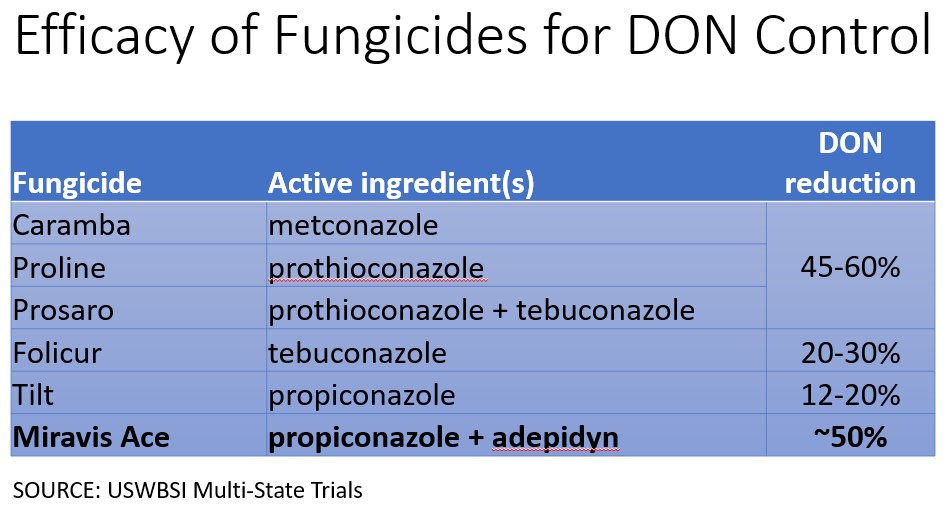
Fungicide efficacy for wheat diseases can be found in the Fungicide Efficacy Table produced by the Crop Protection Network at the following link: https://cropprotectionnetwork.s3.amazonaws.com/fungicide-efficacy-for-control-of-wheat-diseases-filename-2021-04-21-154024.pdf
Scouting for Wheat Diseases:
Begin scouting for wheat diseases around flag leaf emergence (Feekes 8) through Feekes 9 which is when the ligule of the flag leaf is visible. Be sure to look in different areas of the field, especially where wheat appears further along.
Pictures and descriptions of early wheat diseases are below.
Septoria tritici blotch: Look for elliptical or diamond-shaped, tan-brown lesions that often have yellowish halos. As lesions enlarge the center of the lesion dies and appears dark with small, dark specks which are fruiting bodies that give the lesion a characteristic speckled appearance. Subsequent lesions on higher leaves generally follow leaf veins, having straight edges and no yellow margin or halo. The dark lesion center and dark speckling is the key to distinguishing Septoria blotch from tan spot or Stagonospora leaf and glume blotch.
Symptoms of Septoria tritici blotch
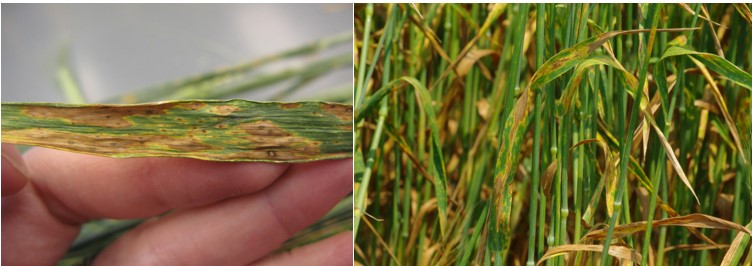
Left is a picture of Septoria blotch showing lesions with dark centers and little to no yellow halo except for new lesions. The right picture illustrates symptoms of larger lesions that have grown together.
Tan spot: Tan spot causes light brown or tan lesion with a light tan center that have a distinctive yellow halo (unlike Septoria that has a dark lesion center). Tan spot lesions are more oval than those of Septoria tritici blotch, but are more angular than Stagonospora leaf blotch lesions.
Symptoms of tan spot
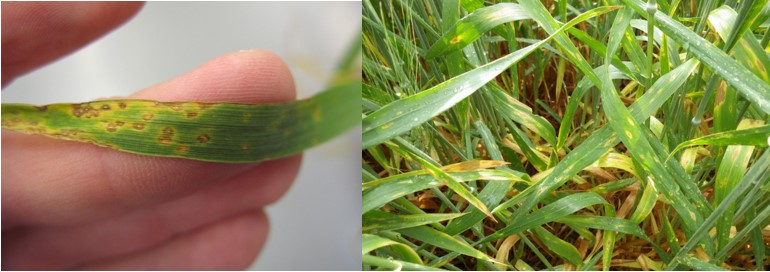
Left is a picture of tan spot lesions that are fairly oval and have tan centers. The right picture demonstrates the characteristic yellow halo caused by tan spot.
Stagonospora leaf and glume blotch: Foliar symptoms generally begin with small yellow flecks or spots. Spots grow to become lens-shaped lesions that are surrounded by yellow halos. Lesions are typically longer than those of tan spot but have a dark center like those of Septoria tritici blotch. However, a yellow halo is often present with Stagonospora and absent with Septoria. Symptoms on glumes appear as purple blotches or streaks.
Stagonospora leaf blotch symptoms
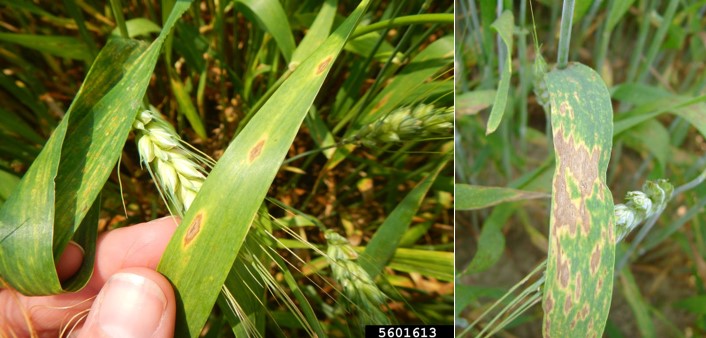
Left are early lesions while the right picture are coalesced lesions in more advanced infections. A distinct yellow halo is almost always present with Stagonospora.
Powdery mildew: Powdery mildew produces powdery, often fluffy fungal growth on stem and leaf surfaces. Leaf tissue can turn yellow under the powdery fungal growth. Signs of this disease typically appear on the lower leaves and work their way up the canopy. In advanced infections, little black dots can be seen in the fungal growth.
Signs of powdery mildew
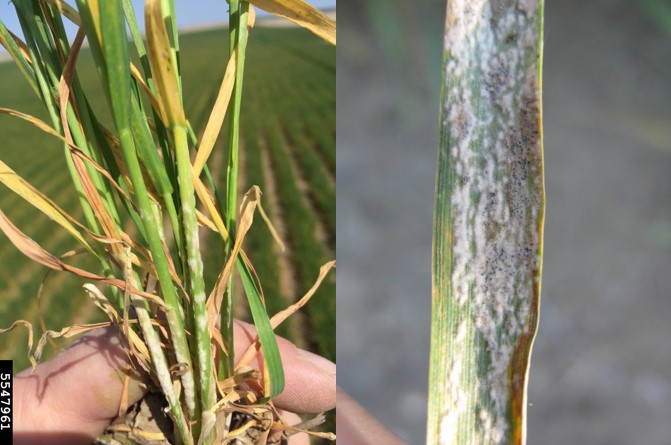
Left is fluffy fungal growth of powdery mildew on lower stems and leaves. On the right can be seen small, black fruiting bodies in the fungal growth.
Stripe rust: Although stripe rust doesn’t appear every year, when it does appear it can cause losses very rapidly. For that reason, you need to contact your local county agent or myself if you suspect stripe rust so we can quickly recommend control measures and alert other growers in the area of occurrence. Like most foliar diseases, strip rust starts out as yellowish flecks on leaves. From lesions appear yellow-orange, rust-like pustules on susceptible varieties. Pustules on mature leaves occur in parallel lines along the length of the leaf which appears as stripes.
Stripe rust symptoms and signs
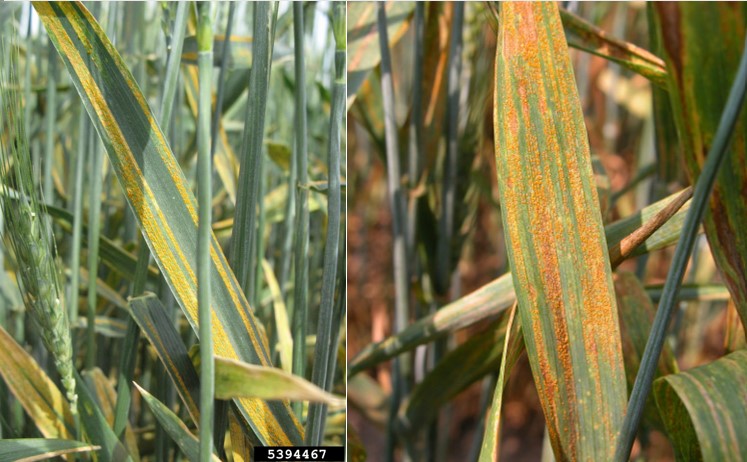
Very linear sporulation and symptoms of stripe rust on left. Larger, coalesced lesions of stripe rust on right.
Most products in the aforementioned efficacy table are effective against these foliar diseases if applied just before or soon after symptoms appear.
